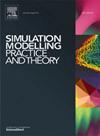2-D deployment of aerial base stations: A simulation model to provide voice communication
IF 3.5
2区 计算机科学
Q2 COMPUTER SCIENCE, INTERDISCIPLINARY APPLICATIONS
引用次数: 0
Abstract
Unmanned aerial vehicles (UAVs) offer a potential alternative for providing voice services in areas where communication is disrupted due to natural disasters. These UAVs can be configured as aerial base stations (ABSs), enabling the deployment of a temporary communications network. However, communication networks based on ABSs pose several significant challenges. One of these challenges involves addressing interruptions or limitations in network coverage caused by natural disasters. In such situations, there is a high likelihood that users within the affected area may be unable to communicate due to a lack of coverage. This is a complex problem because it depends on factors, such as the mobile user locations, the characteristics of the air-to-ground channel, and geographical details of the area. In this work, we propose an optimization model to determine the placement of a set of ABSs within a limited disaster area that maximizes the probability of successful voice services (PSVSs). This optimization model integrates a network evaluation model that analyzes the wireless environment at a specific time. The network evaluation model utilizes two-ray and Rayleigh channel models, enabling the simulation of a worst-case scenario for wireless communication systems. We evaluate the proposed optimization model using the (1+1)-evolution strategy with a one-fifth success rule. We explore various parameter configurations to understand their impact on algorithm performance. This analysis helps identify the configuration of the optimization model that yields the maximum PSVSs. Simulation results indicate that by appropriately configuring the evolution strategy algorithm and comparing random ABS locations with those determined ABS locations by the evolution strategy algorithm, the PSVS can be enhanced by an average of 60%.
空中基站的二维部署:提供语音通信的仿真模型
无人驾驶飞行器(uav)为在因自然灾害而通信中断的地区提供语音服务提供了一种潜在的替代方案。这些无人机可以被配置为空中基站(abs),能够部署一个临时通信网络。然而,基于abs的通信网络提出了几个重大挑战。其中一项挑战涉及解决自然灾害造成的网络覆盖中断或限制。在这种情况下,受影响区域内的用户很可能由于缺乏覆盖而无法通信。这是一个复杂的问题,因为它取决于各种因素,如移动用户的位置、空对地信道的特性和该地区的地理细节。在这项工作中,我们提出了一个优化模型,以确定在有限的灾区内放置一组abs,从而最大限度地提高成功语音服务(PSVSs)的概率。该优化模型集成了分析特定时间无线环境的网络评估模型。网络评估模型利用双射线和瑞利信道模型,能够模拟无线通信系统的最坏情况。我们使用(1+1)-进化策略和五分之一成功规则来评估所提出的优化模型。我们探讨了各种参数配置,以了解它们对算法性能的影响。此分析有助于确定产生最大psv的优化模型的配置。仿真结果表明,通过合理配置进化策略算法,将随机ABS位置与进化策略算法确定的ABS位置进行比较,可使车辆的PSVS平均提高60%。
本文章由计算机程序翻译,如有差异,请以英文原文为准。
求助全文
约1分钟内获得全文
求助全文
来源期刊

Simulation Modelling Practice and Theory
工程技术-计算机:跨学科应用
CiteScore
9.80
自引率
4.80%
发文量
142
审稿时长
21 days
期刊介绍:
The journal Simulation Modelling Practice and Theory provides a forum for original, high-quality papers dealing with any aspect of systems simulation and modelling.
The journal aims at being a reference and a powerful tool to all those professionally active and/or interested in the methods and applications of simulation. Submitted papers will be peer reviewed and must significantly contribute to modelling and simulation in general or use modelling and simulation in application areas.
Paper submission is solicited on:
• theoretical aspects of modelling and simulation including formal modelling, model-checking, random number generators, sensitivity analysis, variance reduction techniques, experimental design, meta-modelling, methods and algorithms for validation and verification, selection and comparison procedures etc.;
• methodology and application of modelling and simulation in any area, including computer systems, networks, real-time and embedded systems, mobile and intelligent agents, manufacturing and transportation systems, management, engineering, biomedical engineering, economics, ecology and environment, education, transaction handling, etc.;
• simulation languages and environments including those, specific to distributed computing, grid computing, high performance computers or computer networks, etc.;
• distributed and real-time simulation, simulation interoperability;
• tools for high performance computing simulation, including dedicated architectures and parallel computing.
 求助内容:
求助内容: 应助结果提醒方式:
应助结果提醒方式:


